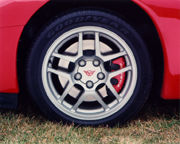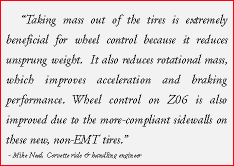GM Press Release: More Agility in the 2001 Corvette
More Agility in the 2001 Corvette
 Note: All information and pictures on this page are courtesy of GM Media Archives.
Note: All information and pictures on this page are courtesy of GM Media Archives.
Second-Generation Active Handling
For 2001 a Second-Generation Active Handling system, much enhanced
over the original, becomes standard equipment on all Corvettes.
Following is a summary of specific changes:
New Pressure Modulator
The original Bosch 5.0 hydraulic pressure modulator is replaced
by an improved Bosch 5.3 modulator. It is reduced in size, transmits
less noise, and works better at low temperatures. It weighs 3.5
pounds less than the previous modulator and provides better apply
response at lower temperatures (-20 degrees Celsius), meaning that
the system will become fully functional more quickly after a cold
start-up.
Dynamic Rear Proportioning
The enhanced system has dynamic rear brake proportioning capability,
electronically balancing rear brake pressure to prevent rear brake
bias, or lockup. This new software feature eliminates the need for
a rear brake circuit-proportioning valve, resulting in fewer assembly
parts and fewer brake pipe connections. In addition, the master
cylinder pressure sensor is now integrated into the new Bosch pressure
modulator.
Sideslip Angle Rate Control
Another upgrade for 2001 is the addition of sideslip angle rate
control to Active Handling's core software algorithm. It senses
whether the driver has been too slow (or too fast) to react to changing
vehicle dynamics during evasive handling maneuvers, then dials in
just the right amount of control to help maintain vehicle balance.
Coefficient
of Friction Estimation
Obviously, the rate at which a car tends to slip sideways is magnified
on slippery road surfaces, so more sophisticated calibration algorithms
have been developed to estimate the friction coefficient of the
road surface and modify the second-generation active handling system's
response accordingly.
Rear Brake Stability Control
One more software change results in better rear brake stability
control. It assists the driver in maintaining control under light
braking and high lateral acceleration conditions, such as might
be encountered if a driver is caught off-guard by a decreasing radius
turn. This new feature more precisely releases brake pressure on
the inside rear wheel during high lateral acceleration maneuvers
and allows for more predictable vehicle response so the driver doesn't
have to work as hard to keep the vehicle on its intended path.
Better Coordination with Traction Control
As noted earlier, Active Handling works in conjunction with the
traction control system, and for 2001 that part of the system has
been much refined. A new control philosophy of targeting specific
rear brake pressures and modulating engine torque around those points
has resulted in fewer engine sags and superior vehicle acceleration
when compared to the 2000 system. This new calibration allows drivers
to enthusiastically experience Corvette's power and handling while
still maintaining control over excessive wheelspin. Average drivers
may now elect to leave the traction control system on when navigating
autocross or gymkhana courses.
 Competitive Mode
Competitive Mode
As alluded to in the previous paragraph, Corvette's Active Handling
system has a unique feature called "Competitive Mode",
which allows the driver to disengage the car's traction control
feature without giving up Active Handling's other benefits. Holding
down the Active Handling button on the center console for five seconds
enables Competitive Mode. This feature recognizes that at the hands
of a highly skilled driver a bit of rear wheelspin may actually
be desirable in autocross or other racing events. In previous years
it was necessary to bring the vehicle to a full stop to enable Competitive
Mode, but for 2001 this requirement has been eliminated.
Taken as a whole, the Corvette's 2001 Second- Generation Active Handling system is smarter, less intrusive, and more adept at making the total driving experience precisely what Corvette owners have come to expect from their cars. It makes the car more agile, allows average drivers to perform better during spirited driving, and provides a new margin of safety in emergency situations.
Special FE4 Suspension for Z06
The Z06 features a suspension system all its own - the FE4 suspension.
It's not available on other Corvette models but is standard equipment
on the Z06. It features a larger front stabilizer bar, a stiffer
rear leaf spring and revised camber settings - all calibrated with
a bias toward maximum control during high-speed operation.
Front stabilizer bar diameter (hollow): 30 mm with 4.5 mm thick
walls
Rear transverse composite spring leaf: 125 N/mm versus 113 N/mm
of the Z51
Camber, front and rear: Z06: -0.75º
Coupe/Convertible: -0.25º.
The Z06's negative camber helps to keep
the tire flatter in relation to the road, and raises the tire
contact patch for greater grip while cornering.
When coupled with other special Z06 components, the combination above provides unparalleled racetrack performance ... what the Z06 is all about.
Special Z06 Wheels
Wider wheels and tires increase the amount of contact with the road,
essential to providing better grip. The standard wheels and tires
on the coupes and convertible are quite satisfactory for the majority
of Corvette customers, but for Z06 buyers the Corvette Team wanted
more.
Z06 wheels are wider front and rear than those on the standard Corvette:
Wheel Size Comparison
| 2001 C5 | 2001 Z06 | |
| Front wheels | 17 in x 8.5 in | 17 in x 9.5 in |
| Rear wheels | 18 in x 9.5 in | 18 in x 10.5 in |
The new wheels are also one of the visual identifiers for the Z06, letting onlookers know that this car is something special. They are uniquely styled, and are the most mass-efficient aluminum wheels ever produced for Corvette. They are painted a light gray metallic, and show off the Z06's red brake calipers, especially when the car is in motion. Each wheel's center cap has a red Corvette crossed-flags emblem for added identification at rest.

Special Z06 Tires
Goodyear has specifically designed new wider, grippier tires for
the Z06. Called Goodyear Eagle F1 SC (Supercar) tires, they allow
the Z06 to handle, brake and perform better than any production
Corvette ever.
Sizewise the new tires differ from the Goodyear Eagle F1 GS EMT tires on coupes and convertible as follows:
Tire Size Comparison
| 2001 C5* | 2001 Z06 | |
| Eagle F1 GS | Eagle F1 SC | |
| Front | P245/45ZR-17 | P265/40ZR-17 |
| Rear | P275/40ZR-18 | P295/35ZR-18 |
 * Coupe/Convertible
* Coupe/Convertible
While larger, these tires are much lighter than the EMT tires, reducing mass by a total of 10.6 kilograms (23.4 pounds).
The new Eagle F1 SC tires have an asymmetric tread pattern to enable the high cornering capabilities of the Z06. With the asymmetric pattern the outside shoulder of the tire performs well in the dry, while the inside tread performs well in the wet. Testing by Mike Neal, Corvette ride and handling engineer, proved that the tires make it very easy to drive the car quickly, have excellent wear attributes, and make the car more recoverable at its handling limits.
Because these new tires do not have the "run-flat" capabilities of the EMT tires, it was necessary to develop a process for dealing with tire punctures, since Corvettes do not come equipped with a spare tire. In the case of the Z06, a GM Tire Inflator Kit is included that is capable of sealing punctures up to 5 mm in diameter.
The kit consists of a squeeze bottle filled with a non-inflammable latex compound in an aqueous base, a nozzle that attaches to the tire valve, and a mini-air compressor with a 12-volt adapter that plugs into the car's accessory power outlet. The kit functions safely in temperatures ranging from -20o to 140o F, under wet or dry conditions, and is easy, fast and clean to use. Similar inflator kits are successfully used by Mercedes and BMW, and Corvettes sold in Japan have been using this inflator kit since the introduction of the C5 in 1997.
The latex compound in the tire inflator kits is not compatible with the tire valves used in Corvette's standard tire pressure monitoring system, so regular tire valves are used and that feature is not offered on the Z06. There is a mass reduction of just over a half-pound as a result.
The Z06's new FE4 suspension, wider wheels, and tires, Second-Generation Active Handling System and reduced weight allow it to take full advantage of all its added power. The Z06's agility and "tossability" are truly remarkable.